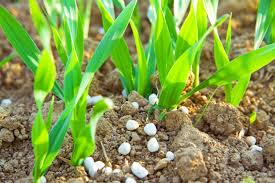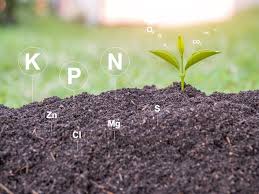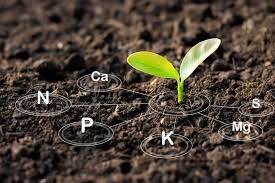Plants, like all other living organisms, require nutrients for growth and development. Sixteen essential elements are needed by plants as nutrients. Elements such as carbon, hydrogen, and oxygen are derived from the atmosphere and soil water.
The remaining 13 essential elements nitrogen, phosphorus, potassium, calcium, magnesium, sulfur, iron, zinc, manganese, copper, boron, molybdenum, and chlorine are supplied either by soil minerals, soil organic matter, or through organic and inorganic fertilizers.
For plants to efficiently utilize these nutrients, adequate light, heat, and water must be provided. Cultural practices, along with disease and pest control, also play vital roles in crop production with respect to nutrient uptake.
Each plant species has unique nutrient requirements, including an optimum nutrient range and a minimum level for proper growth. When nutrient levels fall below the minimum requirement, plants begin to show deficiency symptoms.
On the other hand, excessive nutrient uptake can lead to poor growth due to toxicity. Hence, the proper application amount and placement of nutrients are critical. This article will explore the essential nutrients, their chemical forms, functions, deficiency symptoms, and recommended nutrient levels.
Read Also: Mushroom Growing Kits
Essential Plant Nutrients and Their Sources

There are 17 critical nutrients for plants. These nutrients must be obtained from the soil or growing medium, where they are present as salts and consumed by plants as ions.
Macronutrients are consumed in larger quantities, while micronutrients are required in smaller quantities. Hydrogen, oxygen, carbon, and nitrogen contribute over 95% of a plant’s dry biomass.
1. Macronutrients: Carbon, hydrogen, oxygen, nitrogen, phosphorus, potassium, calcium, magnesium, and sulfur are required in larger amounts for plant growth.
2. Micronutrients: Iron, copper, zinc, boron, molybdenum, manganese, sodium, zinc, nickel, chlorine, cobalt, aluminum, silicon, vanadium, and selenium are needed in trace amounts for plants’ vegetative and reproductive growth.
Functions of Key Nutrients in Plant Growth
1. Carbon (C), Hydrogen (H), and Oxygen (O) contribute 85-90% of the total plant content and are essential for the plant’s structural integrity and metabolic processes.
2. Nitrogen (N) plays a crucial role in promoting dark green color in plants and boosting vegetative growth. It is involved in the synthesis of amino acids and proteins, aiding in the preparation of starch in leaves.
3. Phosphorus (P) is a vital component of nucleic acids, phospholipids, and coenzymes, and regulates plant water balance. It aids in the synthesis of energy molecules (ATP) and catalyzes many enzymatic processes.
4. Calcium (Ca) is essential for cell wall formation, promoting early root development, and enhancing the uptake of other nutrients.
Read Also: Mushroom farming at home
Sources and Importance of Essential Nutrients
Below is a summary of the essential plant nutrients, their categories, and their sources:
| Category | Nutrient | Source of Supply |
|---|---|---|
| Macronutrients | Carbon, Hydrogen, Oxygen | Air and water |
| Primary Macronutrients | Nitrogen, Phosphorus, Potassium | Soil |
| Secondary Macronutrients | Sulfur, Calcium, Magnesium | Soil |
| Micronutrients | Iron, Molybdenum, Boron, Copper, Manganese, Zinc, Nickel, Chlorine, etc. | Soil |
Plant Nutrient, Forms Available to Plants, Functions, and Deficiency Symptoms

1. Nitrogen (N)
i. Form Available to Plants: Nitrate (NO₃⁻), Ammonium (NH₄⁺)
ii. Functions: Vital for amino acid and protein synthesis, chlorophyll production, and enzyme activation.
iii. Deficiency Symptoms: Stunted growth, yellowing of older leaves, reduced protein content, and early maturity leading to yield reduction.
2. Phosphorus (P)
i. Form Available to Plants: Orthophosphate ions (HPO₄²⁻, H₂PO₄⁻)
ii. Functions: Plays a key role in energy storage, genetic information transfer, and root and flower development. It is also essential for seed and fruit development.
iii. Deficiency Symptoms: Slow, weak growth, purpling of leaves and stems, delayed maturity, and poor seed and fruit production.
3. Potassium (K)
i. Form Available to Plants: Potassium ion (K⁺)
ii. Functions: Involved in enzyme activation, water regulation, photosynthesis, and protein synthesis.
iii. Deficiency Symptoms: Chlorosis at leaf margins, stunted growth, weak stems, reduced seed and fruit size, and increased disease susceptibility.
4. Calcium (Ca)
i. Form Available to Plants: Calcium ion (Ca²⁺)
ii. Functions: Crucial for cell wall integrity, enzyme activation, and protein synthesis.
iii. Deficiency Symptoms: Yellowing of leaf tips, poor root growth, curled leaves, and premature bud drop.
5. Magnesium (Mg)
i. Form Available to Plants: Magnesium ion (Mg²⁺)
ii. Functions: Component of chlorophyll, involved in photosynthesis, protein synthesis, and carbohydrate transfer.
iii. Deficiency Symptoms: Interveinal chlorosis in older leaves, premature leaf drop, and poor growth in acid soils or those rich in potassium.
6. Sulfur (S)
i. Form Available to Plants: Sulfate ion (SO₄²⁻)
ii. Functions: Essential for amino acid and protein synthesis, helps in seed production, chlorophyll formation, and nodule formation in legumes.
iii. Deficiency Symptoms: Chlorosis, stunted growth, and delayed maturity, often observed in sandy soils with low organic matter.
7. Boron (B)
i. Form Available to Plants: Borate (H₃BO₃)
ii. Functions: Critical for root growth, pollen germination, lignin synthesis, and cellular activities.
iii. Deficiency Symptoms: Stunted growth, thickened leaves, brittleness, and specific crop-related symptoms (e.g., hollow hearts in peanuts, distorted fruit in papaya).
8. Copper (Cu)
i. Form Available to Plants: Copper ion (Cu²⁺)
ii. Functions: Essential for photosynthesis and involved in enzyme activation and chlorophyll stability.
iii. Deficiency Symptoms: Stunted growth, distorted younger leaves, and dieback in trees. Young leaf tips and growing points are affected in grasses.
The proper management of nutrients, both macro and micro, ensures healthy plant growth and maximizes crop yields. Understanding and addressing nutrient deficiencies in crops is crucial for sustainable agricultural practices and optimal crop production.
9. Chlorine (Cl)
i. Symbol: Cl available to plants as the chloride ion (Cl–)
ii. Nutrient Functions
a. Cl is essential in photosynthesis, where it aids in the evolution of oxygen.
b. It increases cell osmotic pressure and the water content of plant tissues.
c. Cl is found in many bacteria and fungi.
d. It helps reduce the severity of certain fungal diseases, such as take-all disease in wheat.
iii. Deficiency Symptoms
a. Chlorosis of younger leaves and wilting of the plant.
b. Deficiency is rare as Cl is found in the atmosphere and rainwater.
10. Iron (Fe)
i. Symbol: Fe; available to plants as Fe²⁺, Fe³⁺
ii. Nutrient Functions
a. Fe is vital in the heme enzyme system, which plays a key role in plant metabolism (photosynthesis and respiration). This includes enzymes like catalase, peroxidase, cytochrome oxidase, and other cytochromes.
b. It is part of the protein ferredoxin and essential for nitrate and sulfate reduction.
c. Fe is required for the synthesis and maintenance of chlorophyll in plants.
d. It is strongly associated with protein metabolism.
iii. Deficiency Symptoms
i. Interveinal chlorosis in younger leaves, where the youngest leaves may turn white.
ii. Deficiency is often observed in alkaline or over-limed soils.
11. Manganese (Mn)
i. Symbol: Mn; available to plants as Mn²⁺, Mn³⁺
ii. Nutrient Functions
a. Mn is part of the plant enzyme system, activating several metabolic functions. It is a constituent of pyruvate carboxylase.
b. Mn participates in the oxidation-reduction processes in photosynthesis and is necessary in Photosystem II, aiding in photolysis.
c. Mn activates indole acetic acid oxidase, which oxidizes indole acetic acid in plants.
iii. Deficiency Symptoms
a. Chlorosis first appears in young tissues.
b. In dicots, chlorosis manifests as tiny yellow spots, whereas monocots show greenish-grey specks at the lower base of younger leaves. The specks may eventually turn yellowish to yellow-orange.
c. In legumes, necrotic areas on cotyledons result in marsh spots.
12. Molybdenum (Mo)
i. Symbol: Mo; available to plants as molybdate (MoO₄²⁻)
ii. Nutrient Functions
a. Mo is a key component of enzymes like nitrate reductase and nitrogenase, which are required for proper nitrogen assimilation in plants.
b. It is also needed by certain soil microorganisms for nitrogen fixation.
iii. Deficiency Symptoms
a. Symptoms are similar to nitrogen (N) deficiency, as Mo aids in N assimilation.
b. Older and middle leaves turn chlorotic, and leaf margins roll inward.
c. Necrotic spots develop at leaf margins due to nitrate accumulation.
d. Deficient plants exhibit stunted growth, and flower formation may be restricted.
13. Zinc (Zn)
i. Symbol: Zn; available to plants as Zn²⁺
ii. Nutrient Functions
a. Zn is necessary for synthesizing tryptophan, which is required for indole acetic acid formation in plants.
b. It is a key component of several metallo-enzymes and is needed for various plant metabolic functions.
c. The enzyme carbonic anhydrase is activated by Zn.
d. Zn also plays a role in RNA and protein synthesis.
Deficiency Symptoms
a. Interveinal chlorosis occurs in younger leaves, often showing distinct banding at the basal part of the leaf.
b. In vegetables, the new leaves are usually smaller, mottled, and chlorotic.
c. In citrus, irregular interveinal chlorosis appears with small, pointed, mottled leaves, and fruit formation is reduced.
d. In legumes, stunted growth with interveinal chlorosis appears in older, lower leaves, and dead tissue may fall from the chlorotic spots.
Do you have any questions, suggestions, or contributions? If so, please feel free to use the comment box below to share your thoughts. We also encourage you to kindly share this information with others who might benefit from it. Since we can’t reach everyone at once, we truly appreciate your help in spreading the word. Thank you so much for your support and for sharing!

